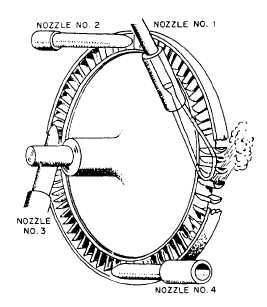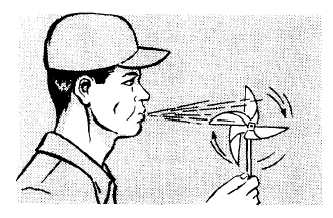Figure 5-2.—Impulse turbine.
Figure 5-3.—Simple impulse turbine principle.
IMPULSE PRINCIPLE
The impulse turbine (fig. 5-2) consists basically
of a rotor mounted on a shaft that is free to rotate
in a set of bearings. The outer rim of the rotor
carries a set of curved blades, and the whole
assembly is enclosed in an airtight case. Nozzles
direct steam against the blades and turn the
rotor.
The energy to rotate an impulse turbine is
derived from the kinetic energy of the steam
flowing through the nozzles. The term impulse
means that the force that turns the turbine comes
from the impact of the steam on the blades.
The toy pinwheel (fig. 5-3) can be used to
study some of the basic principles of turbines.
When you blow on the rim of the wheel,
it spins rapidly. The harder you blow, the
faster it turns. The steam turbine operates
on the same principle, except it uses the
kinetic energy from the steam as it leaves a
steam nozzle rather than air.
Steam nozzles (hereafter referred to as nozzles
or stationary blades) are located at the turbine
inlet. As the steam passes through a nozzle,
potential energy is converted to kinetic energy.
This steam is directed toward the turbine blades
and turns the rotor. The velocity of the steam is
reduced in passing over the blades. Some of its
kinetic energy has been transferred to the blades
to turn the rotor.
Impulse turbines may be used to drive forced
draft blowers, pumps, and main propulsion
turbines.
Figure 5-2 shows an impulse turbine as steam
passes through the nozzles.
REACTION PRINCIPLE
The ancient turbine built by Hero operated on
the reaction principle. Hero’s turbine was invented
long before Newton’s time, but it was a working
model of Newton’s third law of motion, which
states: “For every action there must bean equal
and opposite reaction.”
If you set an electric fan on a roller skate, the
roller skate will take off across the room (fig. 5-4).
The fan pushes the air forward and sets up a
breeze (velocity). The air is also pushing backward
on the fan with an equal force, but in an
opposite direction.
If you try to push a car, you will push
back with your feet as hard as you would
push forward with your hands. Try it sometime
when you are standing on an icy road. You
will not be able to move the car unless you
can dig in with your feet to exert the backward
force. With some thought on your part, you
could come up with examples to prove to
yourself that Newton’s third law of motion
holds true under all circumstances.
5-2




